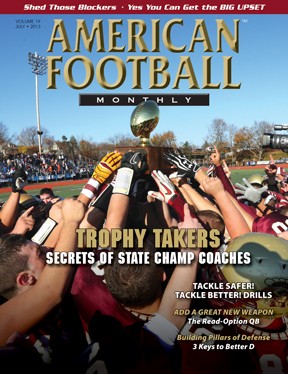Article CategoriesAFM Magazine
|
Coach to Coach – Upset Alert: 5 Ways to Plan Against Superior Opponents.by: Bryon HamiltonAssociate Head Coach and Offensive Coordinator, Shasta College © More from this issue On October 6th 2007, the Stanford Cardinals arrived at the LA Coliseum for a football game against the University of Southern California Trojans. USC was riding a 35-game home winning streak and was one of the more dominant football teams and programs in the modern era. The Cardinal, who were coming off a 1-11 2006 campaign, were being led to the expected slaughter by first- year coach Jim Harbaugh, who would be starting a backup quarterback with a total of three passes on his resume. Las Vegas oddsmakers were so convinced that USC would have their way in the contest that they made the Trojans a whopping 41-point favorite. Harbaugh, however, didn’t buy into the Trojan hype. He had devised a game plan and scenario that, if executed properly, would at least give his undermanned team a chance to be competitive and maybe even shock the football world. By the time the final gun sounded, the Cardinal had pulled off the biggest point spread upset in NCAA history, 24-23. The Stanford win launched both the Cardinal football program and coach Jim Harbaugh to the front page of every newspaper in the country. Upsets of this magnitude are rare. However, every season, at every level of football, undermanned teams compete and win games against superior opponents. Some coaches and programs seem to have a knack for pulling off upset wins on a regular basis. Boise State is a program that comes to mind when I think of teams who have competed and won against schools who in recruiting, history, facilities and budget have a huge advantage. What is the formula for an upset? What are some the key ingredients to winning games where you are the underdog? One way to answer this question is to “reverse engineer” it. When you’re favored in a game, what are some of the pitfalls that may result in a loss? Some of the common things coaches point out are avoiding turnovers, never underestimating your opponent, not giving up easy touchdowns and not allowing the special teams unit to change the course of a game. These are universal themes when it comes to winning games against an inferior opponent. So, in constructing a game plan to beat a superior opponent, winning in these areas will give you and your team a chance to win the game despite having inferior talent and resources. The following are five ingredients that will allow you and your team to pull off an upset win and follow in the path of the 2007 Stanford Cardinal. Special teams usually play a huge part in upset wins. Special teams often allow you to match your best players against your opponents’ second-string players. If you choose this strategy, you can usually have a physical advantage in approximately 25 percent of the game. This game plan may put your best players at a slightly increased risk for injury, but the payoff can be huge if you decide to play your best in all phases of the game. If you research major upsets in high school and college football, a blocked kick, a blocked punt or kick return for a touchdown is often the catalyst for victory. One way that you can improve your chances of staying close until the end is to avoid giving up the big score. A superior team is going to have some success scoring points, but making sure that they have to go through layers to do it can keep you in the game. One mistake that a coach with an inferior team can make is subscribing to the notion that he has to do a something dramatic to win. This thinking can lead to risky play calling that often results in quick scores by the opponent. Even the best teams have a hard time completing 10-play drives on a consistent basis. The more they have to work, the more frustrating the players and coaches will become. |
|
| HOME |
MAGAZINE |
SUBSCRIBE | ONLINE COLUMNISTS | COACHING VIDEOS |
Copyright 2024, AmericanFootballMonthly.com
All Rights Reserved




